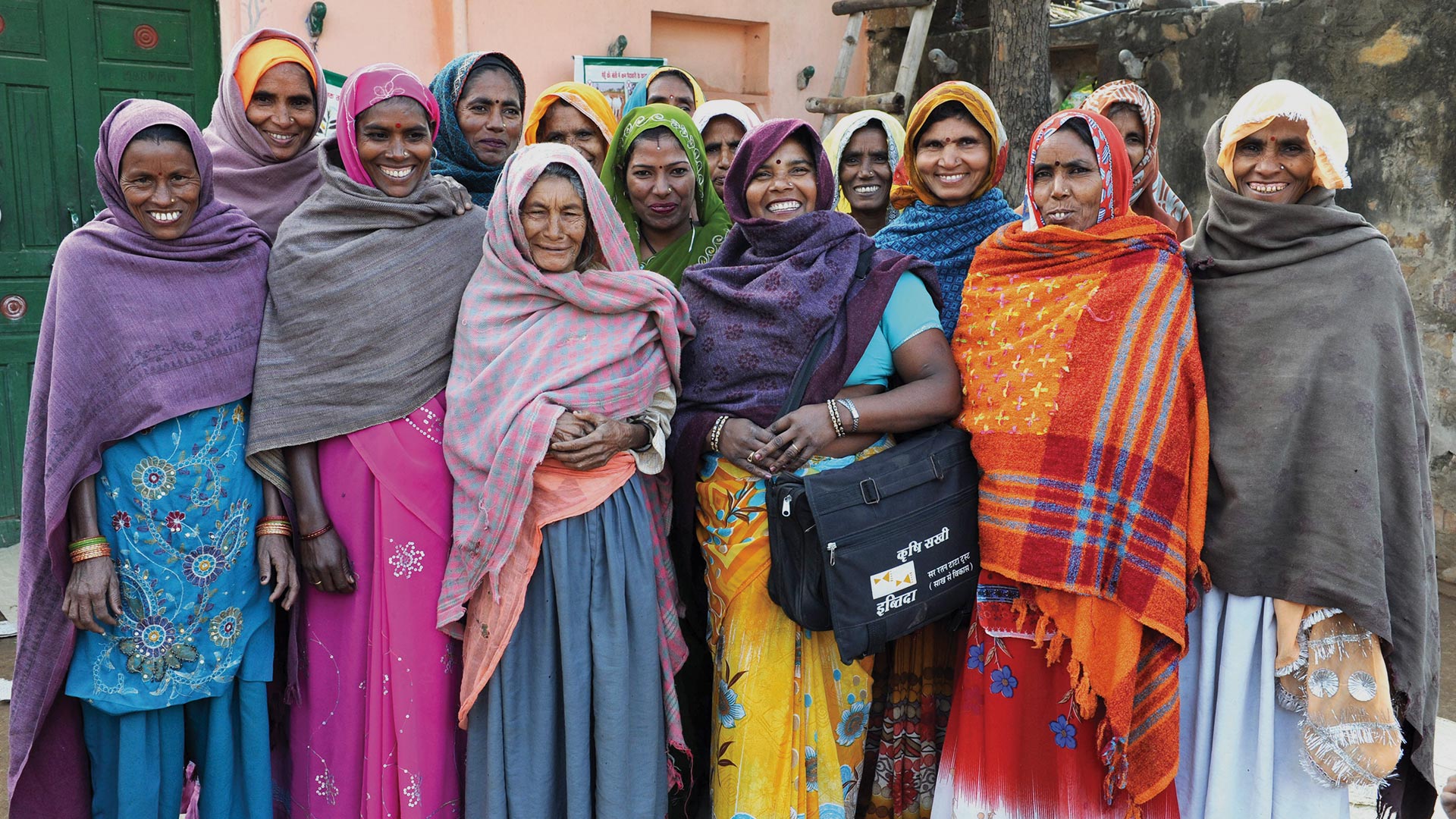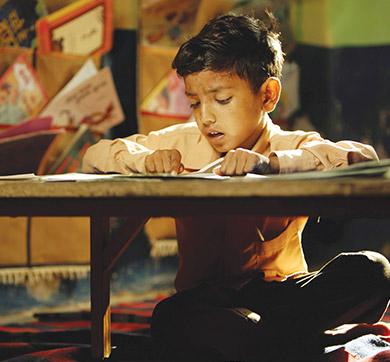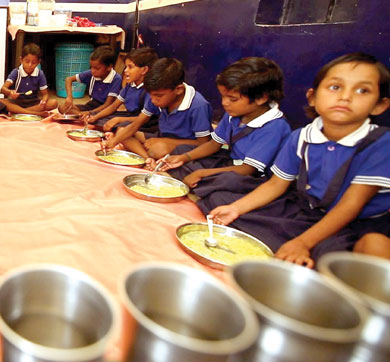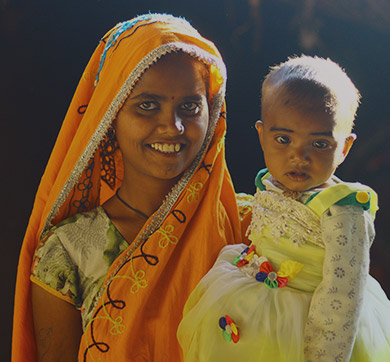June 2020 | 2246 words | 8-minute read
A hut — and hardship — was all that we had when I got married and came here,” says Kamlesh Jatav, casting an eye around the marble-floored drawing room of her two-tiered home in Pathroda Ka Bas village in Rajasthan’s Alwar district.
Her well-appointed dwelling aside, the 37-year-old Ms Kamlesh runs two garment shops and a beauty parlour and is the chairperson of a federation of self-help groups (SHGs) with a sisterhood of more than 2,500 women in its hospitable fold.
From a past of near destitution to a present of once-inconceivable comfort, Ms Kamlesh and her family have never had it so good.
The story of how Ms Kamlesh found her way out of want, and her place in the world, is a capsule in a chronicle of collective social development that has advanced the cause of more than 165,000 women of 9000+ self help groups, from 2000+ villages across 12 districts of Rajasthan, over a period of two decades.
The theme is livelihoods and SHGs are the vehicles of delivery in an inclusive initiative with multiple dimensions: financial inclusion through microcredit schemes; improving agricultural practices; seeding alternate income generation opportunities; food security and nutrition; maternal and child health; and digital literacy.
Promoted and nurtured by the Tata Trusts, the Sakh-Se-Vikas (SSV) programme banks on women, the majority of them from scheduled caste and scheduled tribe communities living in Rajasthan’s most backward regions.
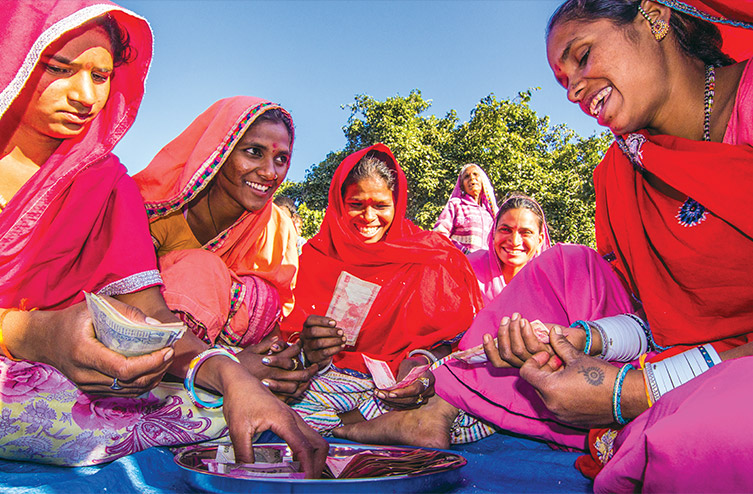
SSV translates into ‘development through credit’ and that’s the centrepiece of an effort which kicked off in 2003, consolidating the concept of SHGs as instruments of progress. The Trusts had been employing the SHG method in the state from about 1998, and this was refined and expanded under SSV. The need driving the deed was stark.
Passed on from generation to generation, poverty can seem like a hereditary disease in places such as Alwar, inevitable in the toll that it takes and immune to quick-fix solutions. Ms Kamlesh and her SHG stablemates have broken the cycle, thanks to their resilience and toil, and with a little help from SSV.
“When I initially heard of the SHG in my village — this was 13 years back — I was working day and night stitching clothes in order to make money,” recalls Ms Kamlesh. “I went for one meeting and my mother-in-law was livid. ‘Don’t go outside the house; you’ll get spoiled,’ she yelled. But I had made up my mind, spoiled be damned.”
Ms Kamlesh and nine other women formed a SHG and there was no turning back for the mother of four. “The first loan I took through the SHG was Rs. 30,000 and I used a third of it to buy a sewing machine,” says Ms Kamlesh. “Then I installed a tap in my house. That mollified my mother-in-law. And things got better when I took a second loan and built a toilet for our family.”
With peace restored on the home front and her husband by her side, Ms Kamlesh grabbed the chance to bloom. She became a leader and was a natural at it. “I learned how to talk to a gathering, how to interact with people.” Ms Kamlesh also discovered in herself a streak of combativeness, and the courage to make it count.
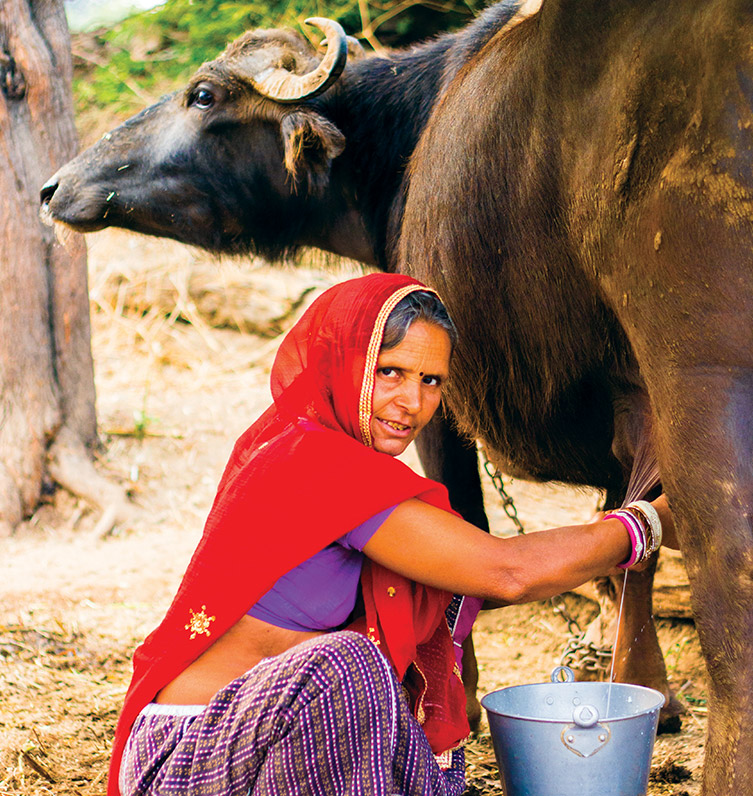
Fiery fight
She gathered together women from nearby villages to tackle what is a recurring nightmare in rural Rajasthan: abusive husbands high on moonshine. “We set the [local alcohol still] on fire,” says Ms Kamlesh, who would go on to spark another women-led uproar, this time to block a highway.
“The village roads were filthy, the drains were choked and there was putrid water about,” says Ms Kamlesh. “Our children had stopped going to school. We had complained to everybody but to no effect, so we decided to take matters into our own hands. People said we would get beaten up but that did not deter us.”
The blockage brought the police and — when that failed to stop the women — the district collector to the protest site. “We got him to come out of his car and see the state in which we lived,” adds Ms Kamlesh. “He asked us to stop the agitation and open the road but we refused. Finally, after about three-four hours and a traffic jam that stretched miles, he committed funds for a clean-up operation.”
There is a line that leads from SSV to village-level activism of the kind that has brought Ms Kamlesh and so many other women onto the radar of panchayat (village council) heads and state government officials. “They talk to us with respect now,” says Ms Kamlesh. The underlaying structure and resultant strength of the SHGs in the programme are the prime reason for that.
The SHGs are organised into clusters and, further on, into federations. The principal objective is to enable poor communities to meet their credit requirements. Making these entities financially reliable, stable and sustainable was a necessity, and that has happened to an ever-greater extent with the passing of the years, so much so that mainstream banks have no hesitation now in lending to them.
It has been a long and fruitful haul for SSV. From 2003 till 2007, the programme concentrated on putting the SHG edifice on a firm footing. The 2008-2012 phase was about adding sinew and muscle to the federations, getting them to function with minimal outside assistance and having them become financially sound.
The 2012-2017 stage looked at enhancing farming- and livestock-based opportunities while linking up with the Indian government’s National Rural Livelihoods Mission and various schemes of the state government, principally the Mitigating Poverty in West Rajasthan (or MPOWER) project. SSV’s horizon has broadened from 2017 to include spheres such as digital literacy and child nutrition.
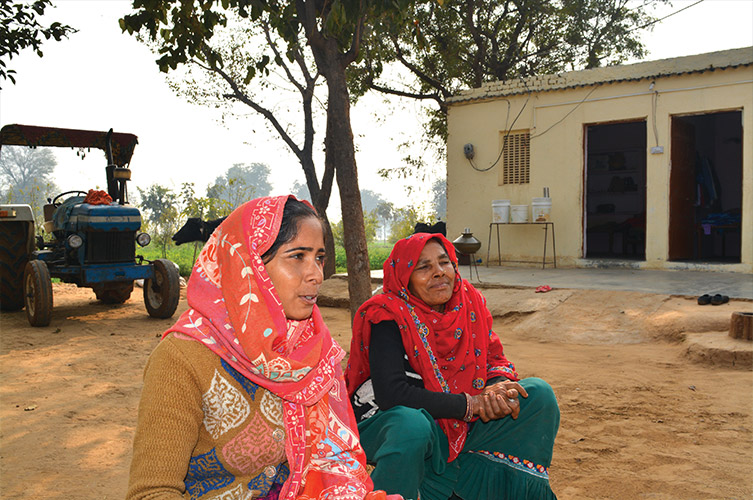
Friends of a feather
They go by the terms krishi sakhis and pashu sakhis (friends of farming and friends of livestock) and they have been an essential feature of the Sakh-Se-Vikas (SSV) programme.
As with the rest of the SSV initiative, the protagonists here are women and they are groomed to provide training and extension services — at the doorstep within villages — in agricultural and animal husbandry practices.
Delivering such services is not new but women doing it is. The cadre of sakhis are paid for their work and they visit various parts of the state, and outside as well, to educate villagers on how to improve productivity on the farm and with livestock.
“We were taught about sowing, soil and weather conditions, planting patterns, the pesticides to use, etc. and we pass on the knowledge,” says 50-year-old Susheela Devi, a krishi sakhi from Bhayadi village in Alwar district.
The responsibilities were similar for Meera Devi, a 45-year-old pashu sakhi from the same village. Getting village women to change their traditional ways was a task but it’s part of the sakhis’ job to convince them — and their husbands — of the merits of their methods.
Ladies first
The dynamic that has stayed consistent throughout has been the wholehearted participation of women in the programme. That is not surprising. Surrounded by taboos and shrouded in ghunghats — a veil worn, mainly in North India, to cover head and face — Rajasthan’s women have for ages suffered the slings of patriarchal prejudices. Sequestered from the harsh traditions of a male-dominated society, SHGs and the women who sustain them have seized the opening to showcase their capabilities.
A standout figure among these women is Saroj Jatav, a 33-year-old homemaker, businesswoman and SHG leader from Dadar village in Alwar district. She owns a sewing shop, a clothes shop and a dairy enterprise, and is a progressive farmer as well. In between all this, Ms Saroj has risen to become secretary of the Savera Mahila Manch, a federation comprising 250 SHGs with some 2,600 members in 46 villages.
Powered by her aptitude and ambition, Ms Saroj’s family has prospered in spades over the course of her association with SSV. In her case, the mother-in-law was not a handicap. “I followed her lead and joined the SHG,” she says. “The first loan I took, Rs. 15,000, was to buy buffaloes. I used to stitch clothes from home and I wanted to turn that into a business, so I took another loan and started a shop.”
Ms Saroj has pumped the money earned into enlarging her small businesses and into the education of the children in her joint family. They study at a private school, “English medium,” she says with a hint of pride. Gone are the shyness and hesitancy that characterised her early days in the SHG. In its place is a vocal confidence about what has been achieved, for herself and her family as much as the SHG movement.
“I’ve got our village women together to tackle common issues: improving agricultural output, getting our girls to go to school and ensuring they don’t drop out, helping women start dairy farming and other small enterprises, building toilets, etc.” says Ms Saroj. “We focus on helping our women members become self-employed. We reckoned that making money for the family ought not to be an exclusively male preserve.”
Issues aplenty
There are sundry subjects crowding Ms Saroj’s agenda. “We want to make certain not a single member of group or federation has to relieve herself in the open,” she adds. “The dowry burden that weighs down our women is another issue we have placed in the forefront. Then there’s making villagers aware of the many schemes instituted by the government for their benefit, be it with rations or pensions.”
Ms Saroj is the eldest of the three daughters-in-law in the family and her ideas for the future include all of them. “I have no doubts whatsoever that we — my family and I as well as the other women in our SHGs — will continue to progress. I’ve been with the programme for seven years and these years have changed by life and my prospects.”
Ms Saroj’s mother-in-law, Muthridevi Jatav, remembers the times before SHGs were set up in their village. “The condition of our women, in particular, was pathetic,” she says. “Awareness was absent and the issues that really concern us were rarely discussed. When the first SHGs were set up, we had no idea how to save collectively, whether loans taken would be repaid or if the concepts being discussed would ever be turned into reality. We saved little by little and we learned little by little.”
Ms Muthridevi began 20 years back by contributing Rs5 a month to the common pool. “It was a lot for many of us, and the men in some families would not even let their wives join the SHG. But then they saw that being an SHG member meant a source of money and they started supporting us. We paid our dues and we had money to set aside. We understood how to work together and to love one another. It seems incredible today.”
There have been challenges galore in putting SSV on an even keel. “It was not easy trying to convince banks to lend money to the SHGs and federations,” says Malika Srivastava, the Tata Trusts’ regional manager for Rajasthan. “Secondly, finding literate people in the village to keep accounts and the rest was a huge challenge (in fact, SHGs were the place where many women learned to count money and to sign their names). Thirdly, the resistance from a feudal society to women stepping out of their homes.”
Ms Srivastava credits the Tata Trusts with always being one step ahead in the livelihoods space in Rajasthan. “We were the pioneers in SHG promotion and with interventions like high-value agriculture. But beyond livelihoods and income increases, there are aspirations in poor households on access to quality education for their children, safe drinking water and better medical facilities at the village level. That’s what we are working towards.”
Fostering for the future
“When we started in 1998, the vision was to build institutions of women which would be self-sustaining, which would work on women’s rights and microfinance and livelihoods,” says Rajesh Singhi, the chief executive of Ibtada, a key implementation partner in the programme. “We had a broad idea that these institutions, if fostered properly, would last for many, many years. And that is what has unfolded.”
Mr Singhi’s regret is the time it has taken for SSV to attach additional facets to the programme. “We were too focused on SHG and livelihoods. We could, perhaps, have diversified earlier into rights and entitlements and into non-farm occupations.”
What has been accomplished thus far, though, is worthy of applause, not least with the intangibles. “SHGs have provided women a platform to seek financial resources and to come together, to be a forum for mutual learning,” says Ms Srivastava. “These women now have mobility, they take decisions for the family, and they have a voice in interactions with village councils and government departments. SHGs have become a force to be reckoned with. This is SSV’s biggest contribution.”
“We are watching a dream unfold in our villages and women are creating the change,” says Ms Kamlesh. “And we don’t exclude men; we call them for our meetings, especially the ones who crib a lot. As for the future, I would like to be a sarpanch [village council head] someday.” How about active politics, maybe becoming a member of the state legislature? “It’s on my list.”
—Philip Chacko
Source: Tata Trusts' Horizons, April 2020 issue




